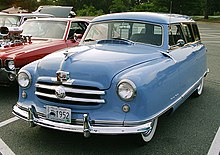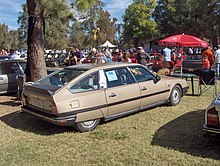





Fender skirts, known in Australia and the United Kingdom as spats or covers, are pieces of bodywork attached to or part of the fender that cover the upper portions of the wheels of a vehicle. They are usually used only on rear wheels, but some models have them on all wheels.
Fender skirts are used for aesthetic and aerodynamic reasons. Rather than the air entering and being trapped in the rear wheel well, it flows smoothly over the bodywork. Fender skirts are generally detachable to allow for tire changes and installation of snow chains.
Fender skirts are typically used on the rear wheels. However, automakers have incorporated integral fender skirts over the front wheel. Nash Motors used wind tunnels during World War II and incorporated aerodynamics' benefits into its 1949 through 1954 Nash "Airflyte" designs.[1] Their shape was the most streamlined form on the road, and the enclosed fenders on all corners eased a path for the air, contributing to the cars' low drag at highway speeds.[1] The compact-sized Nash Rambler from 1950 until 1954 also featured aerodynamic enclosed fenders that blended the sides of the body.[2] However, the front wheels must pivot for steering and extending out from the sides of the vehicle when turning if the front and rear track is equal. Nash claimed that the stability was not affected by the front wheels having a narrower 54.7 in (1,389 mm) track for the front wheels while the rear track was 59.7 in (1,516 mm).[3]
The 1955 Ford Thunderbird introduced rear "fender shields" as a type of fender skirt with an edge molding and a gravel shield.[4] In General Motors parts accessories books, fender skirts are known as fender shields.
First described as "pants", they were used for the streamlining effect by Frank Lockhart on a 1928 Stutz land speed record attempt car.[5] Factory production of fender skirts began with the 1932 Graham-Paige.[6] Aesthetically streamlined designs were copied to mass-produced models.[7] The innovations introduced by Amos Northup, such as the V'd radiators, fender skirts, and sloping beaver-tails, became common after 1933.[7] The fender skirt became a unique styling feature for cars of the past, "making them look like glorious floating boats, classy and elegant".[8] Fender skirts remained a feature for some time longer on a few cars, particularly full-size American luxury cars. By the 1970s, fender skirts began to disappear from mass-market automobiles.
Fender skirts were often paired with whitewall tires. The extent of the skirt also varied; before the 1950s, it was common for all but the very bottom of the rear tire to be covered, while by the 1960s, fender skirts only covered some of the top of the tire and were largely absent on cars other than top-line models. From the mid-1960s until 1976, the Chevrolet Caprice, Oldsmobile 98, Buick Electra, Pontiac Bonneville, and the Cadillac Fleetwood, DeVille, and Calais models used fender skirts. The Cadillac Eldorado models featured fender skirts from 1971 through 1974. Starting in 1977, only the Pontiac Bonneville retained the use of fender skirts on General Motors' downsized cars. In 1980, the Oldsmobile returned the fender skirts to its 98 model. By 1985, fender skirts disappeared from all standard General Motors cars. In 1989, fender skirts were used again on the Cadillac front-wheel drive Fleetwood models until 1993. For the 1991–1996 model years, General Motors generally incorporated fender skirts into the design of their full-size sedans for the Chevrolet Caprice, Buick Roadmaster, and Cadillac Fleetwood. The General Motors EV1 also had fender skirts.
When making Kustoms, fender skirts are an accessory to close the rear fenders and add a special kind of sleekness.[9] In European automobile design, Citroën notably used fender skirts on nearly all models produced between 1950 and 1990, most prominently in the DS, 2CV, Ami, GS, SM, BX, and CX. To enhance fuel economy, the General Motors EV1 electric car included fender skirts.[10] Mass production models with fender skirts included the first-generation Honda Insight and the Clarity in 2016. In 2013, the limited-production Volkswagen XL1 also used fender skirts.
Fender skirts are available for some new cars such as aftermarket accessories (the Chrysler PT Cruiser and Volkswagen Beetle, for example). The fender skirt accessory may arguably not contribute to the aesthetics of modern cars, but look "either tacky, strange, outlandish, or just plain ugly."[8]
Analysis by General Motors indicated three problems with using fender skirts to reduce aerodynamic drag.[11] The problem between the fit of the tires and the body is that either the track has to be narrower or the body pulled out.[11] The removable skirts are more expensive with attachment problems.[11] The reduction of airflow causes higher tire pressures.[11]
Some cities, such as Los Angeles, have fender skirts on municipal buses for safety purposes, as they can prevent items on the road from slipping under the tires.
|
| |||||||||||||
|---|---|---|---|---|---|---|---|---|---|---|---|---|---|
Part of a series of articles on cars | |||||||||||||
| Body |
| ||||||||||||
Exterior |
| ||||||||||||
| |||||||||||||